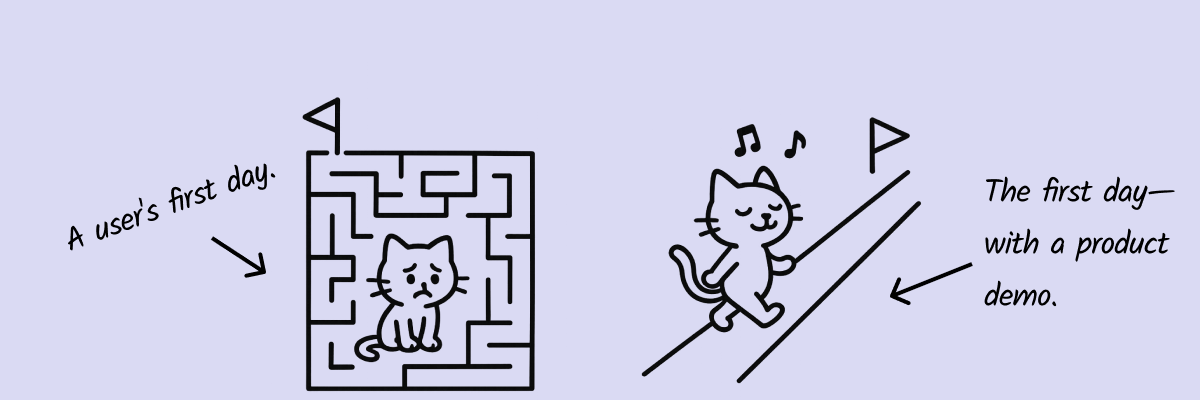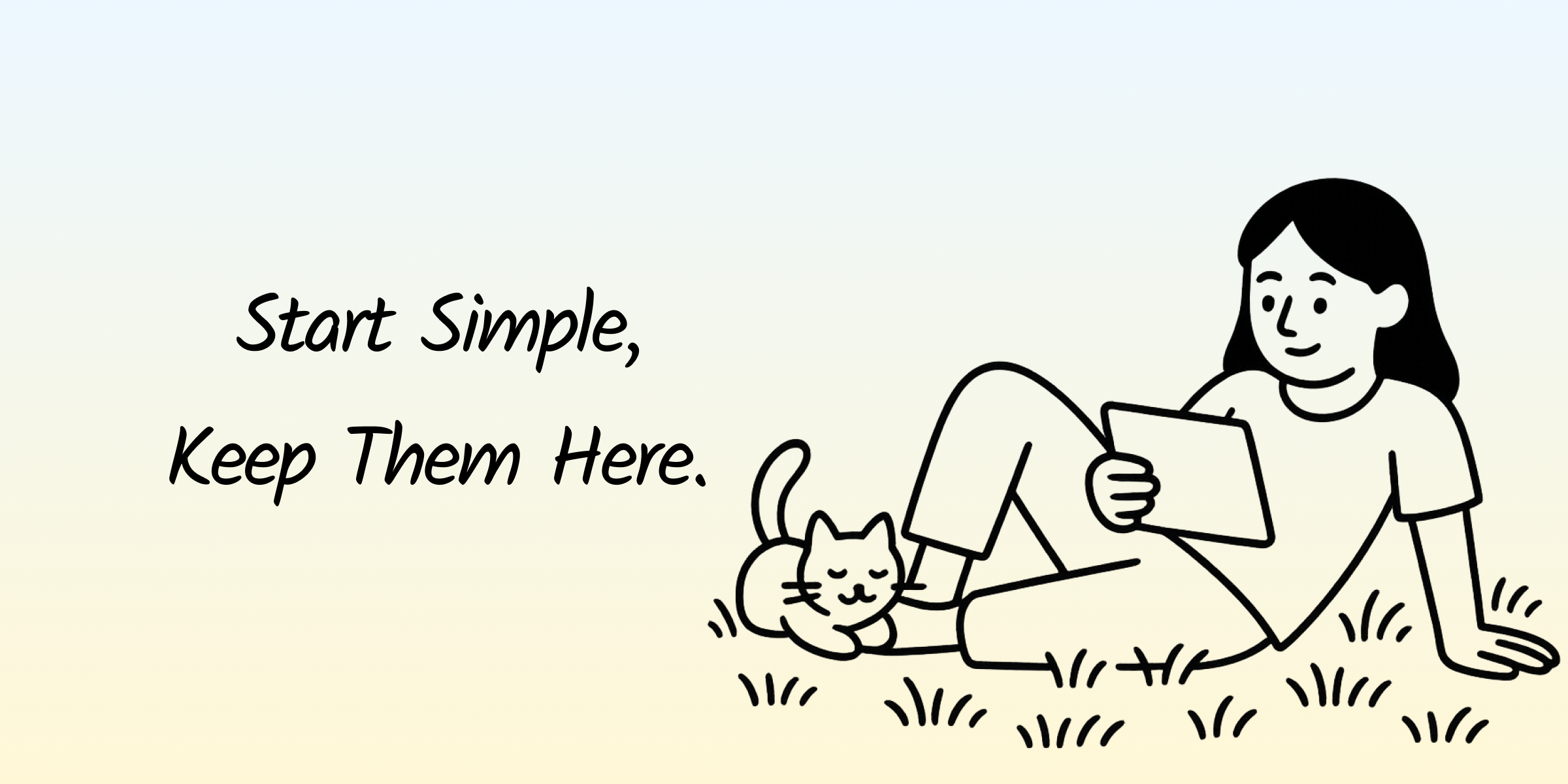“Max, I just added an event listener mechanism and set up a callback for Snapdemo.🤖”
“...Can you speak human language, please?🙄”
“Oh, it just means I added a button. When you click it, you can change the style.😅”
This kind of conversation plays out between us almost every week. Coming from an engineering background, he talks about features with endless enthusiasm. For him, that technical description felt perfectly natural. But for me, it felt more like solving a riddle.
A simple feature gets wrapped in what sounds like a complicated, confusing explanation.
Over time, we realized: this habit of "speaking in expert language" is actually one of the most common barriers between a product and its users.
To us, the product is familiar territory—something we shape and refine every day. But for a new user, it’s an unexplored maze.
Without clear guidance or intuitive demonstrations, users often end up lost, unsure of what to do next—and eventually, they quietly walk away.
And reducing that kind of user churn doesn't come from writing longer manuals.
It comes from creating a great Product Demo.

Why Product Demos Matter for Reducing Churn
In the early stages of a product, churn tends to be higher, especially for emerging SaaS companies, where it can reach as much as 15%. At first, we thought that as long as our onboarding and copy clearly explained the product, users would naturally understand how to use it.
But we soon learned: understanding ≠ being able to use; knowing a feature exists ≠ knowing when and why to use it.
The moment a user first encounters your product often determines whether they'll stick around—especially if that early experience builds trust and momentum from the start:
"What problems can I solve with this? Where should I click? What’s the next step?"
If they don’t find those answers quickly, even a powerful product can feel “😕too complicated,” “❌irrelevant,” or “🙅♂️not for me.”
This gap in perception is one of the root causes of user churn.
And that’s exactly where a good Product Demo comes in:
It shortens the path—showing users what the product can do, how to do it, and what changes they’ll experience afterwards.
It’s not just about guidance—it’s about building trust.
Real product experiences speak louder than words, creating strong first impressions that help users stick around.
How Product Demos Help Reduce User Churn
Why do users churn?
More often than not, it’s not because the product is bad. It’s because users:
- Don’t immediately see the product’s value;
- Find the path to success too complicated or unclear;
- Hit a roadblock early on with no help in sight;
- Get overwhelmed by too many features and don't know where to start.
A Product Demo directly addresses these issues by helping users:
- Quickly understand the value (“Ah, this is what it’s for!”);
- Successfully complete an important first action (the famous "Aha Moment");
- Grasp the overall structure while staying focused on key tasks;
- Avoid the early frustration of getting lost or giving up.
📌 In short, the role of a Product Demo is not just to “inform”—it’s to align:
It brings the journey you want users to take closer to the journey they think they should take.
Once users feel confident about the first step, it becomes much easier for them to keep going.
And users who keep moving forward are users who naturally stick around.

What Makes a Product Demo Truly Effective?
There’s no one-size-fits-all formula for a good Product Demo.
Should it showcase the big picture or focus on one specific scenario?
Should it present every feature or highlight a single solution?
The answer depends on the context.
For example, a demo on your homepage should quickly communicate the overall value:
"What can this product do? Is it worth exploring further?"
The goal here isn’t deep storytelling—it’s a clear, well-paced overview of capabilities.
Meanwhile, in a help center or customer support setting, users already come with a specific problem.
Here, a demo should go straight to the point, showing clear, step-by-step guidance to solve that issue.
The key is: Not every demo needs to cover everything. Not every demo needs a full story.
A well-designed demo doesn’t just teach users how to use your product—it speaks their language, at the right moment, addressing the problems they care about most.
And that kind of positive, frictionless experience is exactly what helps to reduce user churn.

Where Product Demos Can Significantly Boost User Retention
When people think about Product Demos, they often picture new user onboarding.
But demos are valuable across the entire user journey.
Demos matter because they rebuild connection every time user understanding falters—and those moments happen everywhere.
For example:
- 🧭 Early onboarding: When users are still unsure about the product’s value, a demo builds confidence (“I can do this!”) and drives activation.
- 🆕 New feature launches: A short demo often beats a changelog, helping existing users quickly grasp what’s new and how it helps them.
- 🧑💻 Customer success training: Reusable demos can dramatically cut training time and ensure a consistent message.
- 📈 Marketing and acquisition pages: A well-placed demo that clearly shows product capabilities can significantly boost click-through and conversion rates.
Put simply:
Anywhere users might get confused or hesitate, that's where a demo should exist.
📌 The real power of demos isn’t just upfront—it’s about supporting users at every critical decision point, helping them keep moving forward.
From Watching to Doing: Why Great Product Demos Drive Action
A demo’s real job isn’t just to inform users—it’s to get them moving.
Many users don't churn because they doubt your product—they churn because they doubt themselves.
Telling them "it’s easy" doesn’t work nearly as well as letting them click and experience it firsthand.
Listing all your features doesn’t help as much as guiding them through a small, meaningful success.
Show ≠ Do. Watching ≠ Trying. Understanding ≠ Using.
A truly effective demo removes barriers:
No sign-up forms, no complex setup—just a chance to try, to act, to succeed.
When users interact with your product—even just a little—they begin imagining themselves using it in real life.
And at that point, conversion isn’t a "next step" anymore.
It’s already happening.

A Great Product Demo Makes Users Feel They’re on the Right Path
A great Product Demo doesn’t aim to dump all the details.
It aims to light up the path.
It doesn’t need to explain everything.
It just needs to guide users to complete one valuable action.
At that moment, the user isn’t just "watching"—they’re succeeding.
For the user, that’s a feeling of confidence and accomplishment.
For the product, it’s a critical milestone:
Users who succeed early are more likely to stay, explore further, and even recommend your product to others.
So, a Product Demo isn’t just about helping your product get understood—
it’s about redefining the entire user journey.
Helping users succeed at the very first step isn't that hard anymore:
With Snapdemo, you can offer a real, hands-on experience—no signups, no credit cards, no friction. We help you start conversions right from the demo itself.

